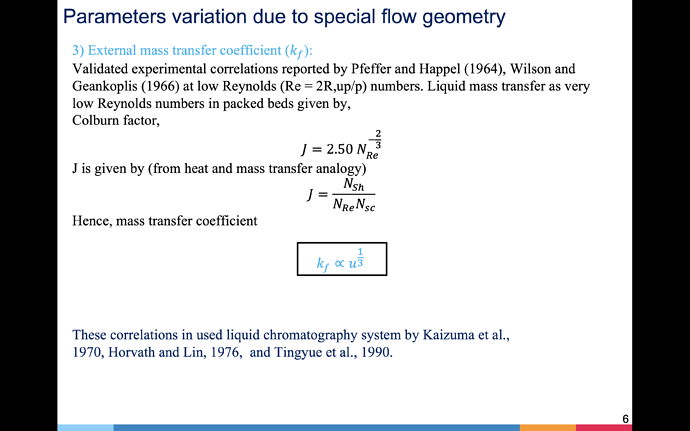When applying finite volumes (a FV cell is a cylindrical shell), we need to apply volume averages:
\frac{1}{V_i} \int_{V_i} f(x) \,\mathrm{d}x,
where the volume is given by V_i = \pi (r_{i+1}^2 - r_i^2) L. Here, L denotes the length of the column in axial direction. Let’s assume that f only depends on the radial position r. This yields
\begin{aligned}
\frac{1}{V_i} \int_{V_i} f(x) \,\mathrm{d}x &= \frac{1}{\pi (r_{i+1}^2 - r_i^2) L} \int_{0}^L \int_0^{2\pi} \int_{r_i}^{r_{i+1}} f(r) r \,\mathrm{d}r \, \mathrm{d}\varphi \, \mathrm{d}z \\
&= \frac{2\pi L}{\pi (r_{i+1}^2 - r_i^2) L} \int_{r_i}^{r_{i+1}} f(r) r \,\mathrm{d}r \\
&= \frac{1}{r_{i+1/2} h_r} \int_{r_i}^{r_{i+1}} f(r) r \,\mathrm{d}r,
\end{aligned}
where h_r = r_{i+1}-r_i is the (uniform) radial size of the shells and r_{i+1/2} = (r_{i+1} + r_i) / 2 is the radial midpoint of cell V_i.
Taking volume averages of the convective term, we yield
\frac{1}{r_{i+1/2} h_r} \int_{r_i}^{r_{i+1}} \frac{v}{r} \frac{\partial c}{\partial r} r \,\mathrm{d}r = \frac{v}{r_{i+1/2} h_r} \left[ c \right]_{r_i}^{r_{i+1}}.
Thus, we need to evaluate c at the radial cell edges r_{i+1} and r_i. Here, we want to apply a WENO scheme.
However, we cannot simply use the standard WENO scheme as we are in cylindrical geometry. For the WENO scheme, we need to find polynomials p_k\colon [r_{i+k-2}, r_{i+k+1}] \to \mathbb{R} whose cell averages coincide with the cell averages of c. That is, polynomials satisfying
\frac{1}{r_{i+k-j+1/2} h_r} \int_{r_{i+k-j}}^{r_{i+k-j+1}} p_k(r) r \,\mathrm{d}r = \frac{1}{r_{i+k-j+1/2} h_r} \int_{r_{i+k-j}}^{r_{i+k-j+1}} c(t,r) r \,\mathrm{d}r \quad \forall \ j \in \{0,1,2\}.
This is equivalent to
\int_{r_{i+k-j}}^{r_{i+k-j+1}} p_k(r) r \,\mathrm{d}r = \int_{r_{i+k-j}}^{r_{i+k-j+1}} c(t,r) r \,\mathrm{d}r = r_{i+k-j+1/2} h_r \hat{c}(t, i+k-j) \quad \forall \ j \in \{0,1,2\}.
The difference to the ordinary / cartesian WENO scheme is the volume element (cartesian: \mathrm{d}z, cylindrical: r \, \mathrm{d}r).


